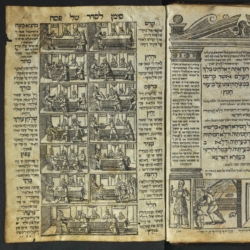A series of fourteen short couplets describing the fourteen traditional stages of the Haggadah, written in Judeo-Italian and first published in the famous 1609 Venice Haggadah of Isaac Gershon. The Italian used in the Venice Haggadah lacks a lot of the most divergent aspects of the Judeo-Italian languages, sticking to a more mainline Tuscan grammatical norm, but there are enough obsolete, poetic, or dialectal forms that several footnotes have been included to explain them. Also included is an original English-language rhyming translation!
TOGGLE COLUMNS (on/off):ADJUST COLUMN POSITIONS: select the column header cell and drag it where you want. show me!COPY INDIVIDUAL COLUMN(S): use CopyTables, a browser extension.
| Source (Judeo-Italian) | Transliteration (Judeo-Italian, romanized) | Translation (English) |
|---|---|---|
קַדֵּשׁ אֵימְפִּיִי אִיל בִּיקְיֵרוֹ בֵּין פְּיֵינוֹ דִי וִינוֹ אֵי דִי קִדּוּשׁ לַאוּדֵי אַל סִינְיוֹר דִיוִינוֹ׃ |
cadesc Émpi il bicchiero[1] A dialectal form. In standard Italian, this word would be written bicchiere. ben pieno di vino e di chidusc laude al Signor divino. |
Ḳadesh Fill the glass good and full of wine, and with the ḳiddush, laud the Lord divine. |
וּרְחַץ לַאוַה לֵי מַאנִי קוֹן אוֹנְיִי אוֹנְדֵיצַה סֵינְצַה פַֿאר בְּרָכָה קוֹן פּוֹלִיטֵיצַה׃ |
urhaz Lava le mani con ogne mondezza senza far berahà con politezza. |
Urḥats Wash the hands in purity complete, without a brakhah, just being neat. |
כַּרְפַּס נֵיל חֲרוֹסֶת דֵיל אַפְּיוֹ אִינְפֿוֹנְדֵירַאִי אֵי בּוֹרֵא פְּרִי הָאֲדָמָה בֵּינֵידִירַאִי׃ |
carpas Nel haróssèt dell’appio infonderai e bore peri ha-adama benedirai. |
Karpas Celery in the ḥaroset[2] The old Italian custom was to dip the karpas in ḥaroset rather than a separate liquid. A different hand in this printing has crossed out the word ḥaroset and written aceto — vinegar — above it. you must infuse, and say borei p’ri ha-adamah as is done by us Jews. |
יַחַץ פַּארְטִּי אִיל שִׁמּוּר דִי מֵיזוֹ אִי מֵיזזוֹ דֵי אֵיסּוֹ סִיאַה פֵּיר אֲפִיקוֹמֶן רִיפּוֹסְטוֹ אֵי מֵיסוֹּ |
giahaz Parti il scimùr di mezzo e mezzo di esso, sia per aficómèn riposto e messo. |
Yaḥats Break the middle’s middle off the matsah tray. To be the afiḳomen it must be hidden away. |
מַגִּיד דִירַאִי לַה הַגָּדָה קוֹמֵי אֵי קְוִי סְקְרִיטוֹ דַא הָא לַחְמָא סִין קֵי אֵיל רֵיסְטוֹ אַבְּיִי דִיטוֹ׃ |
magghid Dirai la hagada come e qui scritto da ha lahma sin che el resto abbi ditto.[3] A dialectal form. In standard Italian, this phrase would be written il resto abbi detto. |
Maggid Say the haggadah as written herein, until all of it’s said — with ha laḥma begin. |
רָחְצָה אוּנַאלְטְרַה ווֹלְטַה לַאוַאטֵי לֵי מַאנִי קוֹן בְּרָכָה סֵינְצַה פֵּינְסְיֵירִי וַאנִי׃ |
rohza Un’altra volta lavate le mani con berahà senza pensieri vani. |
Roḥtsah Once again, wash your hands. With a brakhah this time, without idle plans. |
מוֹצִיא מַצָּה פִּילִיַיה אִיל שִׁמּוּר דִי סוֹפְּרַה אֵי צִי פַּארַאִי הַמּוֹצִיא לֶחֶם אֵי נוֹן נֵי מַאנְיַארַאִי׃ מַה סְפֵּיצַה קְוֵילַה מֵיזַה אֵי דֵיטוֹ פּוֹאִי עַל אֲכִילָת מַצָּה מַאנְיַיה אַמְבִּי דּוֹאִי׃ |
mozzi mazza Piglia il scimùr di sopra e ci farai hamozzi lehem, e non ne mangiarai.[4] A dialectal form. In standard Italian, this word would be written mangerai. Ma spezza quella mezza e detto poi gnal ahilat mazza — mangia ambi doi. |
Motsi Matsah Pick up the matsot on top of the set. Say ha-motsi leḥem but don’t eat it yet! But break that half, over which is quoth: ‘al akhilat matsah — now eat them both! |
מָרוֹר נֵיל חֲרוֹסֶת לַטוּקַה אַוְורַאִי אִינְפֿוּסַה קוֹן דִיר עַל אֲכִילָת מָרוֹר קֵי סְ אוּסַה׃ |
maror Nel haróssèt lattuca avrai infusa con dir gnal ahilat maror che s’usa. |
Maror In ḥaroset you’ll make romaine be infused. Saying ‘al akhilat maror, as it is used. |
כּוֹרֵךְ דֵיל טֵירְצוֹ שִׁמּוּר ווֹלְגִיי אִין אוּנַה פֿוֹלְיַיה אֵי דִי זֵכֶר לַמִּקְדָּשׁ דִּי מַאלַה ווֹלְיַיה׃ |
coréch Del terzo scimùr volgi in una foglia[5] In modern Italian, this word is exclusively used for a plant’s leaf. A metaphorical “leaf” — i.e. a folded food as intended here, would be referred to as a sfoglia instead — puff pastry, for instance, is pasta sfoglia. e di zeher lamicdasc di mala voglia. |
Korekh The third matsah fold like a book. And for zekher la-miqdash with a reluctant look. |
שֻׁלְחָן עוֹרֵךְ קוֹנְצִיַיה לַה מֵינְסַה אֵי אִיל צִיבּוֹ אִין בּוֹקַה קַאצִיַה אֵי מַאנְיַיה קְוַאנְטוֹ ווֹאִי קֵי פְּרוֹ טִי פַֿאצִיַה׃ |
sciulhan gnoréch Concia la mensa e il cibo in bocca caccia e mangia quanto voi che pro ti faccia. |
Shulḥan ‘Orekh Set the table, stuff your face with the food. And eat as much as you feel in the mood. |
צָפוּן לְאֲפִיקוֹמֶן קֵי גְיַה אַאִי רִיסֵירְבַאטוֹ אִין פִֿין קוֹן דֵיווֹצִיוֹן סַארַה מַאנְיַאטוֹ׃ |
zafun L’aficómèn che già hai riservato in fin, con devozion’[6] This is the first of multiple words in this portion written without their final vowel, a process known as apocope and common in Italian poetry to this day. Most of these words, excepting commonly abbreviated forms such as dir for dire, are here written with an apostrophe to mark the elided vowel. sarà mangiato. |
Tsafun The afiḳomen, already set aside, in the end will be eaten in devotion and pride. |
בָּרֵךְ סֵינְצַה מַאנְיַיאר נֵי בֵּיר אַלְטְרוֹ פְּרוֹקוּרַה דִּיר בְּרָכָה אֵי פֵּיר זִמּוּן פּוֹן קוּרָה׃ |
baréch Senza mangiar’ né ber’ altro procura dir berahà e per zimmun pon’ cura. |
Barekh Without eating or drinking Anything more, Bentsh with a zimmun, at least three or more. |
הַלֵּל שְׁפוֹךְ קוֹמִינְצִיַיה אֵיט אִיל הַלֵּל פִֿינִישִׁי אֵי קְוֵיל קֵי טִי אַה סַאלְוַטוֹ בֵּינֵידִישִׁי׃ |
Hallel We start with Shefókh and with Hallel we’re ending. Bless the One who saved you with a strong hand extending! | |
נִרְצָה פְּרֵיגַה אִידִיוֹ קֵי אִיל בּוֹן ווֹלֵיר אַצֵיטַה אֵי קֵי אִין יְרוּשָׁלִַם צִי רִימֵטַה׃ |
nirza Prega Iddio che il bon[9] A dialectal form. In standard Italian, this word would be written buon. voler’ accetta e che in Gieruscialaim ce rimetta! |
Nirtsah Pray that God accepts this good-willed. With us may Jerusalem once more be filled! |
Source(s)
Notes
| 1 | A dialectal form. In standard Italian, this word would be written bicchiere. |
|---|---|
| 2 | The old Italian custom was to dip the karpas in ḥaroset rather than a separate liquid. A different hand in this printing has crossed out the word ḥaroset and written aceto — vinegar — above it. |
| 3 | A dialectal form. In standard Italian, this phrase would be written il resto abbi detto. |
| 4 | A dialectal form. In standard Italian, this word would be written mangerai. |
| 5 | In modern Italian, this word is exclusively used for a plant’s leaf. A metaphorical “leaf” — i.e. a folded food as intended here, would be referred to as a sfoglia instead — puff pastry, for instance, is pasta sfoglia. |
| 6 | This is the first of multiple words in this portion written without their final vowel, a process known as apocope and common in Italian poetry to this day. Most of these words, excepting commonly abbreviated forms such as dir for dire, are here written with an apostrophe to mark the elided vowel. |
| 7 | An obsolete form of the prevocalic “and.” In modern Italian, it would, in poetic contexts, be written ed. |
| 8 | A dialectal form. In standard Italian, this word would be written benedici. |
| 9 | A dialectal form. In standard Italian, this word would be written buon. |

“Judeo-Italian couplets for each course of the Passover Seder (Venice, 1609)” is shared through the Open Siddur Project with a Creative Commons Attribution-ShareAlike 4.0 International copyleft license.











Comments, Corrections, and Queries